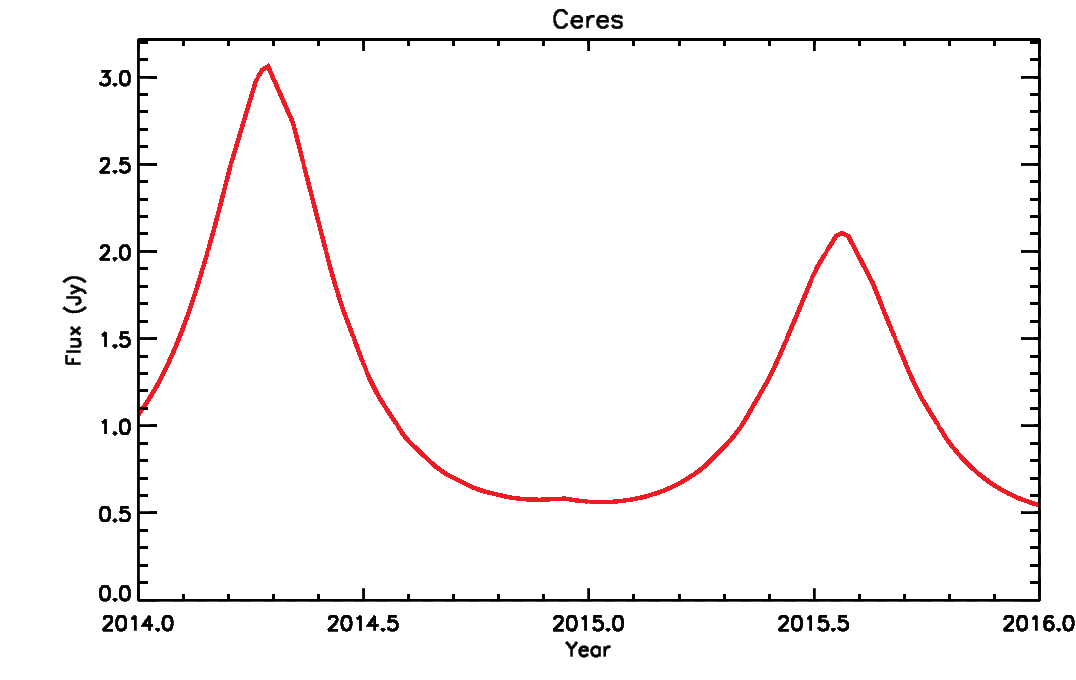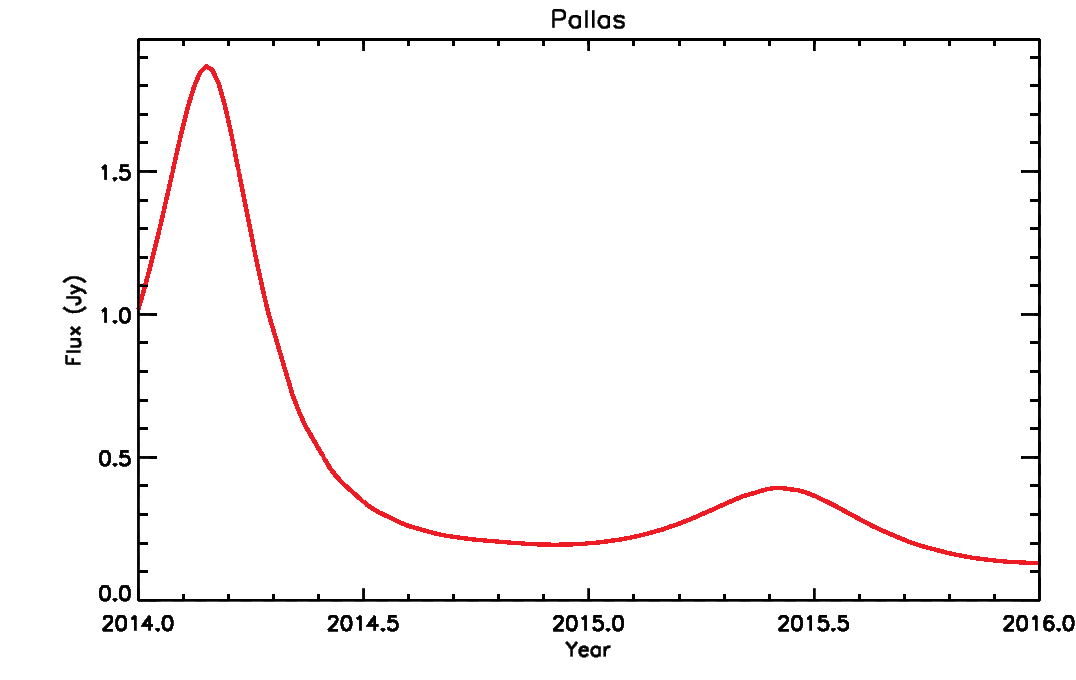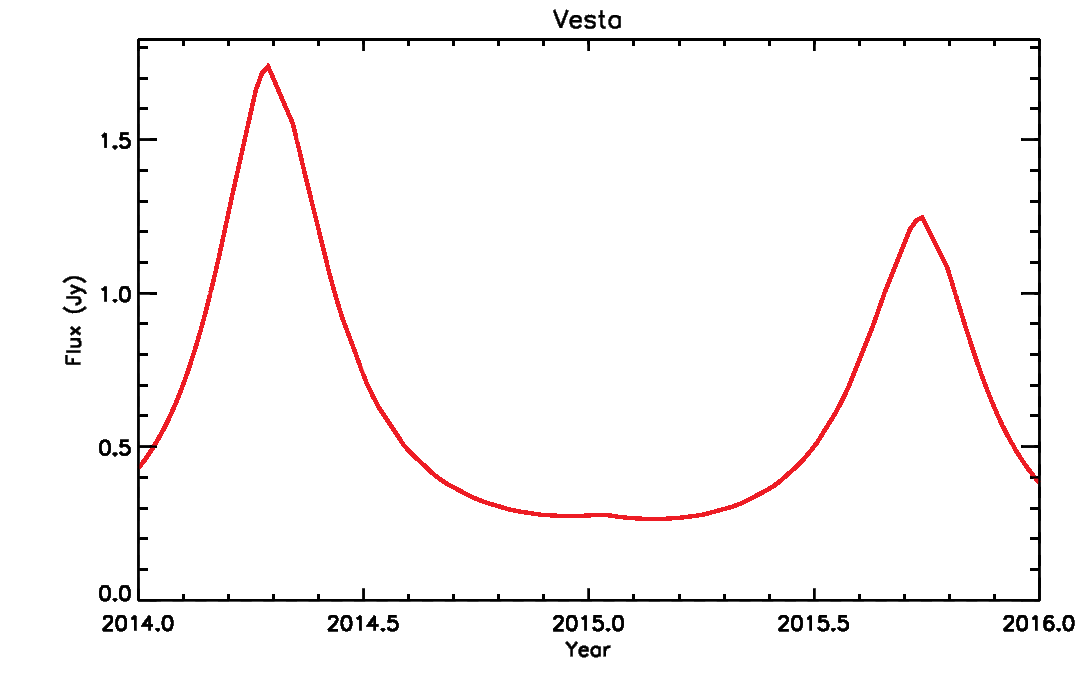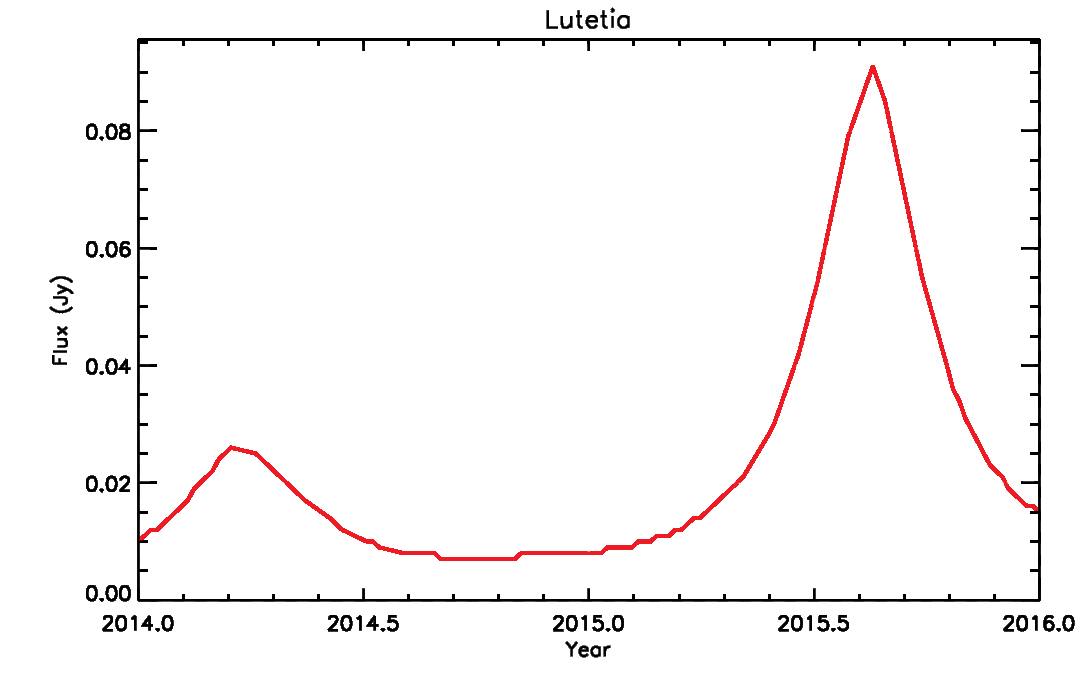Pointing sources and calibrators
Ephemerides for the sources listed here are included in the IRAM 30m Catalogue for Continuum Cameras (v beta). This catalog can be opened with XEphem.
Contents
Pointing Sources
The ongoing IRAM flux monitoring program provides flux estimates for most of the pointing sources included in the Catalog. These data are provided ONLY to help in the planning of observations, in particular to select pointing and focus sources at the IRAM 30-m telescope. They should not be used for any other purpose.
Primary Calibrators
The primary calibrators used at the IRAM 30m telescope are Mars, Uranus and Neptune. The following table provides flux measurements taken at the IRAM 30m radiotelescope:
Planet |
MAMBO Flux [Jy] |
NIKA 1 mm Flux [Jy] |
NIKA 2 mm Flux [Jy] |
GISMO Flux [Jy] |
Comments |
MARS |
108.36 |
|
|
56.70 +/- 6.95 |
MAMBO: 824 onoffs. GISMO: 27 scans CAREFUL: distance to Mars and hence its flux varies strongly |
URANUS |
36.62 |
|
|
15.10 +/- 4.33 |
MAMBO: 420 onoffs. GISMO: 97 scans |
NEPTUNE |
13.99 |
|
|
7.48 +/- 3.97 |
MAMBO: 48 onoffs. GISMO: 15 scans |
MAMBO fluxes were extracted from the IRAM DataBase for Pooled Observations (go to astro -> Calib Sources).
Secondary calibrators
The following list provides flux measurements for a list of secondary calibrators to be observerd when planets are not visible.
Source |
RA [J2000] |
DEC [J2000] |
Size ["] |
MAMBO Flux [Jy] |
NIKA 1 mm Flux [Jy] |
NIKA 2 mm Flux [Jy] |
GISMO Flux [Jy] |
Comments |
G34.3 |
18:53:18.56 |
+01:14:58.2 |
11x9 |
19.90 +/- 0.80 |
|
|
|
MAMBO: 572 onoffs. |
G10.62 |
18:10:28.66 |
-19:55:49.7 |
-- |
9.12 +/- 0.00 |
|
|
|
MAMBO: 241 onoffs. |
W3OH |
02:27:03.88 |
+61:52:24.5 |
17x10 |
8.13 +/- 0.40 |
|
|
6.43 +/- 1.24 |
MAMBO: 551 onoffs. GISMO: 32 scans |
K3-50A |
20:01:45.69 |
+33:32:43.5 |
11x9 |
6.66 +/- 0.20 |
|
|
|
MAMBO: 231 onoffs. |
NGC7538 |
23:13:45.38 |
+61:28:10.3 |
16x13 |
5.79 +/- 0.50 |
|
|
8.97 +/- 2.62 |
MAMBO: 300 onoffs. GISMO: 15 scans |
IRAS16293 |
16:32:22.70 |
-24:28:32.0 |
10 |
5.30 +/- 0.30 |
|
|
|
MAMBO: 105 onoffs. |
CepA |
22:56:17.93 |
+62:01:49.5 |
27x15 |
3.82 +/- 0.20 |
|
|
|
MAMBO: 162 onoffs. |
NGC7027 |
21:07:01.59 |
+42:14:10.1 |
9x8 |
3.14 +/- 0.10 |
|
|
3.36 +/- 0.26 |
MAMBO: 139 onoffs. GISMO: 3 scans |
CRL618 |
04:42:53.35 |
+36:06:52.6 |
6x5 |
2.93 +/- 0.10 |
|
|
|
MAMBO: 366 onoffs. |
G45.1 |
19:13:22.07 |
+10:50:53.4 |
13x9 |
2.69 +/- 0.20 |
|
|
|
MAMBO: 264 onoffs. |
GL490 |
03:27:38.84 |
+58:47:00.5 |
16x11 |
2.11 +/- 0.20 |
|
|
|
MAMBO: 175 onoffs. |
CRL2688 |
21:02:18.80 |
+36:41:37.6 |
9x2 |
1.83 +/- 0.10 |
|
|
|
MAMBO: 97 onoffs. |
MWC349 |
20:32:45.57 |
+40:39:36.4 |
<0.5 |
1.70 +/- 0.10 |
|
|
|
MAMBO: 86 onoffs. |
L1551-IRS5 |
04:31:34.17 |
+18:08:05.1 |
15x11 |
1.51 +/- 0.20 |
|
|
|
MAMBO: 634 onoffs. |
CW-LEO |
09:47:57.38 |
+13:16:43.6 |
14x13 |
1.29 +/- 0.05 |
|
|
|
MAMBO: 1125 onoffs. |
LKHALF234 |
21:43:06.79 |
+66:06:54.4 |
21x14 |
1.00 +/- 0.10 |
|
|
|
MAMBO: 291 onoffs. |
HLTAU |
04:31:38.45 |
+18:13:57.9 |
7x3 |
0.96 +/- 0.05 |
|
|
|
MAMBO: 231 onoffs. |
HD-163296 |
17:56:21.29 |
-21:57:21.9 |
-- |
0.69 +/- 0.20 |
|
|
|
MAMBO: 4 onoffs. |
LKHALF101 |
04:30:14.40 |
+35:16:24.1 |
-- |
0.57 +/- 0.00 |
|
|
|
MAMBO: 117 onoffs. |
ALF-ORI |
05:55:10.28 |
+07:24:25.4 |
7x3 |
0.34 +/- 0.02 |
|
|
|
MAMBO: 133 onoffs. |
MAMBO fluxes were extracted from the IRAM DataBase for Pooled Observations (go to astro -> Calib Sources; positions there are given in the J2000 coordinate system, and not as indicated in the header as B1950.0!!). See also the secondary calibrators for continuum measurements report by Lisenfeld et al. (2000).
Asteroids
Some asteroids have quite excentric orbits, and their temperatures thus vary quite a bit. In addition, the smaller ones have non-circular shapes and thus also rotational variability on scales of few hours. However, the four largest asteroids (Ceres, Pallas, Vesta, and Lutetia) present a flux accuracy better than 5% and therefore, they can be used as reliable calibrators for the IRAM 30m continuum cameras (see the poster courtesy of Thomas Mueller).
Thomas Mueller provided flux predictions at different wavelengths for these four asteroids until 2020:
Ceres, Pallas, Vesta, Lutetia
Observers have to give the oribital elements of the asteroids to pako: perihelionEpoch, ascendingNode, argumentOfPerihelion, inclination, perihelionDistance, eccentricity. The elements listed below were extracted from the JPL Ephermides data base by X.Desert. Asteroids are on stable orbits. Their orbital elements are not expected to change.
PAKO> SOURCE Body Ceres 2456551.202069534158 80.32764144660911 72.29215117844517 10.59398142371781 2.557090856996202 .07579725984872261 PAKO> SOURCE Body Pallas 2456634.320680106518 173.1023717671647 309.9337060321055 34.83625656930519 2.130435195136733 .2315650120848084 PAKO> SOURCE Body Vesta 2456923.695134388993 103.8514828145328 151.1995756082146 7.140518203879475 2.152395790927782 .08850244223456388 PAKO> SOURCE Body Lutetia 2457274.428494472523 80.88533411704726 250.2363739926752 3.06386567315565 2.034005484901541 .1644593151184061




Polarized Calibrators
Source |
RA [J2000] |
DEC [J2000] |
S(1mm) [Jy] |
p(1mm) [%] |
x(1mm) [deg] |
Comments |
3C286 |
13:31:8.30 |
+30:30:33.0 |
0.30 +/- 0.03 |
14.4 +/- 1.8 |
33.1 +/- 5.7 |
Bright compact radio quasar. XPOL observations from Sep 2006 to Jan 2012 |
S(1mm), p(1mm), and x(1mm) are the flux density, the polarization fraction, and the polarization angle at 1 mm measured with the XPOL polarimeter at the IRAM 30m Telescope.
Author: Israel Hermelo (IRAM 30m Continuum Pool Manager)
email: hermelo@iram.es
Created: 2014.01.14
Last update: 2014.02.11
